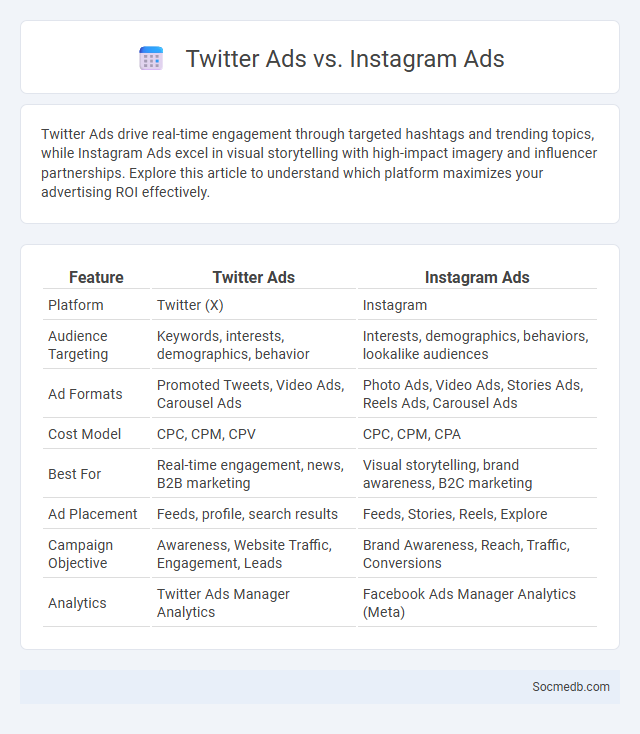
Photo illustration: Twitter Ads vs Instagram Ads
Twitter Ads drive real-time engagement through targeted hashtags and trending topics, while Instagram Ads excel in visual storytelling with high-impact imagery and influencer partnerships. Explore this article to understand which platform maximizes your advertising ROI effectively.
Table of Comparison
| Feature | Twitter Ads | Instagram Ads |
|---|---|---|
| Platform | Twitter (X) | |
| Audience Targeting | Keywords, interests, demographics, behavior | Interests, demographics, behaviors, lookalike audiences |
| Ad Formats | Promoted Tweets, Video Ads, Carousel Ads | Photo Ads, Video Ads, Stories Ads, Reels Ads, Carousel Ads |
| Cost Model | CPC, CPM, CPV | CPC, CPM, CPA |
| Best For | Real-time engagement, news, B2B marketing | Visual storytelling, brand awareness, B2C marketing |
| Ad Placement | Feeds, profile, search results | Feeds, Stories, Reels, Explore |
| Campaign Objective | Awareness, Website Traffic, Engagement, Leads | Brand Awareness, Reach, Traffic, Conversions |
| Analytics | Twitter Ads Manager Analytics | Facebook Ads Manager Analytics (Meta) |
Introduction to Social Media Advertising
Social media advertising leverages platforms like Facebook, Instagram, LinkedIn, and Twitter to target specific audiences with precision using demographics, interests, and behaviors. It offers scalable solutions for brand awareness, lead generation, and sales conversions through formats such as sponsored posts, video ads, and carousel ads. Data-driven analytics and audience segmentation enable marketers to optimize campaigns and maximize return on investment (ROI).
Overview of Twitter Ads
Twitter Ads offer a powerful platform for reaching a diverse and engaged audience through targeted campaigns that include promoted tweets, accounts, and trends. With customizable options such as audience segmentation by demographics, interests, and behaviors, businesses can optimize ad spend and maximize ROI. Your brand's visibility and engagement can significantly increase by leveraging Twitter's real-time analytics and performance tracking tools for continuous campaign improvement.
Overview of Instagram Ads
Instagram Ads offer targeted advertising solutions that leverage Facebook's extensive data to reach specific audiences based on demographics, interests, and behaviors. These ads appear in various formats including Stories, Feed, Reels, and Explore, supporting photo, video, carousel, and shopping options to boost engagement and conversions. With advanced analytics and A/B testing tools, businesses can optimize campaign performance and drive measurable ROI on the platform.
Understanding General Ad Campaigns
General ad campaigns on social media leverage targeted audience data, platform algorithms, and varied ad formats to maximize engagement and conversions. Understanding how to optimize targeting, budget allocation, and creative content can significantly improve your campaign's effectiveness. Mastering these elements ensures your ads reach the right users at the right time, driving better ROI.
Target Audience Comparison
Analyzing target audience demographics across major social media platforms reveals distinct user preferences and behaviors critical for effective marketing strategies. Instagram attracts younger users aged 18-34 with a strong emphasis on visual content, while Facebook maintains a broader age range, including users over 35, favoring community engagement and diverse media types. LinkedIn targets professionals seeking networking and B2B connections, making it ideal for campaigns focused on career development and industry insights.
Ad Formats and Creative Options
Social media platforms offer diverse ad formats including carousel ads, video ads, story ads, and sponsored posts, each designed to capture user attention effectively. Creative options range from interactive polls and augmented reality filters to shoppable posts, enabling you to tailor campaigns that boost engagement and conversions. Leveraging these dynamic ad formats and creative tools maximizes your brand's visibility and drives targeted traffic.
Budgeting and Cost Differences
Social media marketing costs vary significantly based on platform, ad format, and targeting options, with budgets typically ranging from a few hundred to several thousand dollars monthly. You can maximize ROI by allocating funds strategically, prioritizing high-performing channels like Facebook, Instagram, or LinkedIn depending on your audience demographics and campaign goals. Understanding cost-per-click (CPC) and cost-per-impression (CPM) metrics helps optimize your budget to achieve measurable engagement and conversions.
Analytics and Performance Tracking
Social media analytics provide detailed insights into audience behavior, engagement rates, and content performance by tracking metrics such as reach, impressions, and click-through rates. Your ability to analyze this data enables optimization of marketing strategies, improving ROI and enhancing brand visibility across platforms like Facebook, Instagram, and Twitter. Performance tracking tools, including Google Analytics and native social media dashboards, empower you to measure campaign success in real-time for informed decision-making.
Pros and Cons of Each Platform
Facebook offers extensive networking opportunities with over 2.9 billion active users, ideal for building communities and targeted advertising, but it faces challenges related to privacy concerns and misinformation. Instagram excels in visual content sharing and influencer marketing, attracting younger audiences, while it can promote unrealistic lifestyles and privacy issues. Twitter provides real-time news updates and direct engagement, yet is often criticized for its character limit and the potential for misinformation and harassment. Evaluating these platforms helps you choose the best fit for your social media goals.
Choosing the Right Platform for Your Campaign
Selecting the right social media platform for your campaign depends on understanding the demographics, user behavior, and content format preferences of each site. Platforms like Instagram and TikTok excel in visual content engagement among younger audiences, while LinkedIn targets professionals and B2B interactions effectively. Tailoring your campaign strategy to the strengths of Facebook, Twitter, or Pinterest enhances reach and drives higher conversion rates.
 socmedb.com
socmedb.com